Elastic and Frictional Properties of Fault Zones in Reservoir-Scale Hydro-Mechanical Models—A Sensitivity Study
Abstract
:1. Introduction
2. Elastic and Frictional Fault Zone Properties
2.1. Elastic Material Properties
2.2. Frictional Material Properties
3. Modelling Concept
3.1. Model Geometry
3.2. Constitutive Laws
3.3. Initial and Boundary Conditions
3.4. Material Parameters
4. Results
4.1. Base Model
4.1.1. Pore Pressure
4.1.2. Magnitude and Orientation of S1,eff
4.1.3. Total, Elastic, and Plastic Strain
4.2. Influence of Young’s Modulus
4.2.1. Magnitude and Orientation of S1,eff
4.2.2. Elastic and Plastic Strain
4.3. Influence of Poisson’s Ratio
4.3.1. Magnitude and Orientation of S1,eff and S2,eff
4.3.2. Elastic and Plastic Strain
4.4. Influence of Cohesion
4.4.1. Magnitude and Orientation of S1,eff
4.4.2. Elastic and Plastic Strain
4.5. Influence of Friction Angle
4.5.1. Magnitude and Orientation of S1,eff
4.5.2. Elastic and Plastic Strain
4.6. Interdependence of Parameters
4.6.1. Elastic Properties (Young’s Modulus vs. Poisson’s Ratio)
4.6.2. Plastic Properties (Cohesion vs. Internal Friction Angle)
5. Discussion
5.1. Base Model
5.2. Variations in Elastic Rock Properties
5.3. Variations in Plastic Rock Properties
6. Conclusions
Author Contributions
Funding
Acknowledgments
Conflicts of Interest
Nomenclature
| α | Biot coefficient |
| c | Cohesion |
| E | Young’s modulus |
| k | Permeability |
| pf | Pore pressure |
| qf | Fluid flux due to Darcy’S law |
| Q* | Compressibility parameter |
| Sf | Degree of fluid saturation |
| S1,eff | Effective maximum principal stress |
| S2,eff | Horizontal effective stress |
| T0 | Tensile strength |
| v | Poisson’s ratio |
| εv | Volumetric strain |
| φ | Internal friction angle |
| σij | Total stress tensor |
| σ′ij | Effective stress tensor |
| δij | Kronecker’s delta |
| ρ | Density |
References
- Cappa, F.; Rutqvist, J. Modeling of coupled deformation and permeability evolution during fault reactivation induced by deep underground injection of CO2. Int. J. Greenh. Gas Control 2011, 5, 336–346. [Google Scholar] [CrossRef] [Green Version]
- Fachri, J.T.M.; Røe, P. Volumetric faults in field-sized reservoir simulation models: A first case study. AAPG Bull. 2016, 100, 795–817. [Google Scholar] [CrossRef]
- Serajian, V.; Diessl, J.; Bruno, M.S.; Hermansson, L.C.; Hatland, J.; Risanger, M.; Torsvik, R.M. 3D geomechanical modeling and fault reactivation risk analysis for a well at brage oilfield, norway. In Proceedings of the SPE Europec Featured at 78th EAGE Conference and Exhibition, Vienna, Austria, 30 May–2 June 2016. [Google Scholar]
- Schuite, J.; Longuevergne, L.; Bour, O.; Burbey, T.J.; Boudin, F.; Lavenant, N.; Davy, P. Understanding the hydromechanical behavior of a fault zone from transient surface tilt and fluid pressure observations at hourly time scales. Water Resour. Res. 2017, 53, 10558–10582. [Google Scholar] [CrossRef] [Green Version]
- Pereira, L.C.; Guimarães, L.J.; Horowitz, B.; Sánchez, M. Coupled hydro-mechanical fault reactivation analysis incorporating evidence theory for uncertainty quantification. Comput. Geotech. 2014, 56, 202–215. [Google Scholar] [CrossRef]
- Rueda, J.C.; Norena, N.V.; Oliveira, M.F.F.; Roehl, D. Numerical models for detection of fault reactivation in oil and gas fields. In Proceedings of the 48th US Rock Mechanics/Geomechanics Symposium, Minneapolis, Minnesota, 1–4 June 2014. [Google Scholar]
- Sanchez, E.C.; Zegarra, E.; Oliveira, M.F.F.; Roehl, D. Application of a 2D equivalent continuum approach to the assessment of geological fault reactivation in reservoirs. In Proceedings of the XXXVI Ibero-Latin American Congress on Computational Methods in Engineering, Rio de Janeiro, Brazil, 22–25 November 2015. [Google Scholar]
- Haug, C.; Nüchter, J.-A.; Henk, A. Assessment of geological factors potentially affecting production-induced seismicity in North German gas fields. Géoméch. Energy Environ. 2018, 16, 15–31. [Google Scholar] [CrossRef]
- Segall, P.; Grasso, J.-R.; Mossop, A. Poroelastic stressing and induced seismicity near the Lacq gas field, southwestern France. J. Geophys. Res. Space Phys. 1994, 99, 15423. [Google Scholar] [CrossRef]
- Morton, R.A.; Bernier, J.C.; Barras, J.A. Evidence of regional subsidence and associated interior wetland loss induced by hydrocarbon production, Gulf Coast region, USA. Environ. Earth Sci. 2006, 50, 261–274. [Google Scholar] [CrossRef]
- Chan, A.W.; Zoback, M.D. The role of hydrocarbon production on land subsidence and fault reactivation in the Loiusiana Coastal Zone. J. Coast. Res. 2007, 24, 771–786. [Google Scholar] [CrossRef]
- Vilarrasa, V.; Makhnenko, R.; Laloui, L. Potential for fault reactivation due to CO2 injection in a semi-closed saline aquifer. Energy Procedia 2017, 114, 3282–3290. [Google Scholar] [CrossRef] [Green Version]
- Wiprut, D.; Zoback, M.D. Fault reactivation and fluid flow along a previously dormant normal fault in the northern North Sea. Geology 2000, 28, 595–598. [Google Scholar] [CrossRef]
- Cuisiat, F.; Jostad, H.P.; Andresen, L.; Skurtveit, E.; Skomedal, E.; Hettema, M.; Lyslo, K. Geomechanical integrity of sealing faults during depressurization of the Statfjord field. J. Struct. Geol. 2010, 32, 1754–1767. [Google Scholar] [CrossRef]
- Faulkner, D.R.; Jackson, C.; Lunn, R.J.; Schlische, R.; Shipton, Z.K.; Wibberley, C.; Withjack, M. A review of recent developments concerning the structure, mechanics and fluid flow properties of fault zones. J. Struct. Geol. 2010, 32, 1557–1575. [Google Scholar] [CrossRef]
- Caine, J.S.; Evans, J.P.; Forster, C.B. Fault zone architecture and permeability structure. Geology 1996, 24, 1025–1028. [Google Scholar] [CrossRef]
- Walsh, J.J.; Bailey, W.; Childs, C.; Nicol, A.; Bonson, C. Formation of segmented normal faults: A 3-D perspective. J. Struct. Geol. 2003, 25, 1251–1262. [Google Scholar] [CrossRef]
- Collettini, C.; Holdsworth, R. Fault zone weakening and character of slip along low-angle normal faults: Insights from the Zuccale fault, Elba, Italy. J. Geol. Soc. 2004, 161, 1039–1051. [Google Scholar] [CrossRef]
- Myers, R.; Aydin, A. The evolution of faults formed by shearing across joint zones in sandstone. J. Struct. Geol. 2004, 26, 947–966. [Google Scholar] [CrossRef]
- Childs, C.; Manzocchi, T.; Walsh, J.J.; Bonson, C.G.; Nicol, A.; Schöpfer, M.P.J. A geometric model of fault zone and fault rock thickness variations. J. Struct. Geol. 2009, 31, 117–127. [Google Scholar] [CrossRef]
- Fasching, F.; Vanek, R. Engineering geological characterization of fault rocks and fault zones. Geomech. Tunn. 2011, 4, 181–194. [Google Scholar] [CrossRef]
- Rawling, G.C.; Goodwin, L.B.; Wilson, J.L. Internal architecture, permeability structure, and hydrologic significance of contrasting fault-zone types. Geology 2001, 29, 43–46. [Google Scholar] [CrossRef]
- Wibberley, C.A.J.; Yielding, G.; Di Toro, G. Recent advances in the understanding of fault zone internal structure: A review. Geol. Soc. Lond. Spéc. Publ. 2008, 299, 5–33. [Google Scholar] [CrossRef] [Green Version]
- Gudmundsson, A. Rock Fractures in Geological Processes by Agust Gudmundsson; Cambridge University Press (CUP): Cambridge, UK, 2009. [Google Scholar]
- Childs, C.; Watterson, J.; Walsh, J.J. A model for the structure and development of fault zones. J. Geol. Soc. 1996, 153, 337–340. [Google Scholar] [CrossRef]
- Gudmundsson, A.; De Guidi, G.; Scudero, S. Length–displacement scaling and fault growth. Tectonophysics 2013, 608, 1298–1309. [Google Scholar] [CrossRef]
- Bauer, J.F.; Meier, S.; Philipp, S.L. Architecture, fracture system, mechanical properties and permeability structure of a fault zone in Lower Triassic sandstone, Upper Rhine Graben. Tectonophysics 2015, 647, 132–145. [Google Scholar] [CrossRef]
- Manzocchi, T.; Heath, A.E.; Palananthakumar, B.; Childs, C.; Walsh, J.J. Faults in conventional flow simulation models: A consideration of representational assumptions and geological uncertainties. Pet. Geosci. 2008, 14, 91–110. [Google Scholar] [CrossRef]
- Olden, P.; Pickup, G.E.; Jin, M.; Mackay, E.J.; Hamilton, S.; Somerville, J.; Todd, A. Use of rock mechanics laboratory data in geomechanical modelling to increase confidence in CO2 geological storage. Int. J. Greenh. Gas Control 2012, 11, 304–315. [Google Scholar] [CrossRef]
- Zhang, Y.; Langhi, L.; Schaubs, P.; Piane, C.D.; Dewhurst, D.N.; Stalker, L.; Michael, K. Geomechanical stability of CO2 containment at the South West Hub Western Australia: A coupled geomechanical–fluid flow modelling approach. Int. J. Greenh. Gas Control. 2015, 37, 12–23. [Google Scholar] [CrossRef]
- Qu, D.; Tveranger, J. Incorporation of deformation band fault damage zones in reservoir models. AAPG Bull. 2016, 100, 423–443. [Google Scholar] [CrossRef] [Green Version]
- Paul, P.K.; Zoback, M.D.; Hennings, P.H. Fluid flow in a fractured reservoir using a geomechanically constrained fault-zone-damage model for reservoir simulation. SPE Reserv. Eval. Eng. 2009, 12, 562–575. [Google Scholar] [CrossRef] [Green Version]
- Johri, M.; Zoback, M.D.; Hennings, P. A scaling law to characterize fault-damage zones at reservoir depths. AAPG Bull. 2014, 98, 2057–2079. [Google Scholar] [CrossRef] [Green Version]
- Zoback, M. Reservoir Geomechanics; Cambridge University Press: Cambridge, UK, 2007. [Google Scholar]
- Hennings, P.; Allwardt, P.; Paul, P.; Zahm, C.; Reid, R.; Alley, H.; Kirschner, R.; Lee, B.; Hough, E. Relationship between fractures, fault zones, stress, and reservoir productivity in the Suban gas field, Sumatra, Indonesia. AAPG Bull. 2012, 96, 753–772. [Google Scholar] [CrossRef]
- Carmichael, R.S. Practical Handbook of Physical Properties of Rocks and Minerals (1988); Informa UK Limited: London, UK, 2017. [Google Scholar]
- Jaeger, J.; Cook, N.G.; Zimmerman, R. Fundamentals of Rock Mechanics, 4th ed.; Wiley-Blackwell: Hoboken, NJ, USA, 2007. [Google Scholar]
- Fjær, E. Relations between static and dynamic moduli of sedimentary rocks. Geophys. Prospect. 2018, 67, 128–139. [Google Scholar] [CrossRef] [Green Version]
- Goodman, R.E. Introduction to Rock Mechanics, 2nd ed.; Wiley: New York, NY, USA, 1989. [Google Scholar]
- Schön, J.H. Physical Properties of Rocks—Fundamentals of Petrophysics; Elsevier: London, UK, 2004. [Google Scholar]
- Eissa, E.A.; Kazi, A. Relation between static and dynamic Young’s moduli of rocks. Int. J. Rock Mech. Min. Sci. Geomech. 1988, 25, 479–482. [Google Scholar] [CrossRef]
- Davarpanah, S.M.; Ván, P.; Vásárhelyi, B. Investigation of the relationship between dynamic and static deformation moduli of rocks. Géoméch. Geophys. Geo Energy Geo Resour. 2020, 6, 1–14. [Google Scholar] [CrossRef] [Green Version]
- Fjær, E.; Holt, R.; Horsrud, P.; Raaen, A.; Risnes, R. Petroleum Related Rock Mechanics, 2nd ed.; Elsevier Science: Amsterdam, The Netherlands, 2008; pp. 103–133. [Google Scholar]
- Brady, B.H.G.; Brown, E.T. Rock Mechanics for Underground Mining, 2nd ed.; Kluwer: London, UK, 1993. [Google Scholar]
- Brace, W.F. An extension of the Griffith theory of fracture to rocks. J. Geophys. Res. Space Phys. 1960, 65, 3477–3480. [Google Scholar] [CrossRef]
- Caddell, R.M. Deformation and Fracture of Solids; Prentice-Hall: Upper Saddle River, NJ, USA, 1980. [Google Scholar]
- Reches, Z.; Lockner, D.A. Nucleation and growth of faults in brittle rocks. J. Geophys. Res. Space Phys. 1994, 99, 18159–18173. [Google Scholar] [CrossRef]
- Hoek, E. Practical Rock Engineering, 2nd ed.; Hoek’s Corner: North Vancouver, BC, Canada, 2013. [Google Scholar]
- Deb, R.; Jenny, P. Modeling of shear failure in fractured reservoirs with a porous matrix. Comput. Geosci. 2017, 21, 1119–1134. [Google Scholar] [CrossRef]
- Byerlee, J. Friction of rocks. Pageoph 1978, 116, 615–626. [Google Scholar] [CrossRef]
- Bell, F.G. Engineering Properties of Soils and Rocks, 4th ed.; Blackwell: Oxford, UK, 2000. [Google Scholar]
- Azarfar, B.; Peik, B.; Abbasi, B. A discussion on numerical modeling of fault for large open pit mines. In Proceedings of the 52th US Rock Mechanics/Geomechanics Symposium, Seattle, WA, USA, 17–20 June 2018. [Google Scholar]
- Holdsworth, R.E. Weak Faults—Rotten Cores. Science 2004, 303, 181–182. [Google Scholar] [CrossRef]
- Syversveen, A.R.; Skorstad, A.; Soleng, H.H.; Røe, P.; Tveranger, J. Facies modelling in fault zones. In Proceedings of the ECMOR X—10th European Conference on the Mathematics of Oil Recovery, Amsterdam, The Netherlands, 4–7 September 2006; pp. 4–7. [Google Scholar]
- Hoek, E.; Martin, C. Fracture initiation and propagation in intact rock–A review. J. Rock Mech. Geotech. Eng. 2014, 6, 287–300. [Google Scholar] [CrossRef] [Green Version]
- Bruhn, R.L.; Parry, W.T.; Yonkee, W.A.; Thompson, T. Fracturing and hydrothermal alteration in normal fault zones. Pure Appl. Geophys. Pageoph 1994, 142, 609–644. [Google Scholar] [CrossRef]
- Barton, N. Review of a new shear-strength criterion for rock joints. Eng. Geol. 1973, 7, 287–332. [Google Scholar] [CrossRef]
- Andersson, J.-E.; Ekman, L.; Nordqvist, R.; Winberg, A. Hydraulic testing and modelling of a low-angle fracture zone at Finnsjön, Sweden. J. Hydrol. 1991, 126, 45–77. [Google Scholar] [CrossRef]
- Faulkner, D.R.; Mitchell, T.M.; Healy, D.; Heap, M.J. Slip on ’weak’ faults by the rotation of regional stress in the fracture damage zone. Nature 2006, 444, 922–925. [Google Scholar] [CrossRef] [PubMed]
- Chiaraluce, L.; Chiarabba, C.; Collettini, C.; Piccinini, D.; Cocco, M. Architecture and mechanics of an active low-angle normal fault: Alto tiberina fault, northern Apennines, Italy. J. Geophys. Res. Space Phys. 2007, 112, 112. [Google Scholar] [CrossRef]
- Collettini, C.; Niemeijer, A.R.; Viti, C.; Marone, C. Fault zone fabric and fault weakness. Nature 2009, 462, 907–910. [Google Scholar] [CrossRef]
- Małkowski, P. Behaviour of joints in sandstones during the shear test. Acta Geodyn. Geomater. 2015, 12, 399–410. [Google Scholar] [CrossRef] [Green Version]
- Sanetra, U. The change of internal friction angle of intact and jointed rock on different depth. In Proceedings of the Mining Workshops, Polska Akademia Nauk, Wydawnictwo, Kraków, Poland, 15–18 June 2005. [Google Scholar]
- Bukowska, M.; Sanetra, U. The tests of the conventional triaxial granite and dolomite compression in the aspect of their mechanical properties. Min. Resour. Manag. 2008, 24, 345–358. [Google Scholar]
- Sulem, J.; Vardoulakis, I.; Papamichos, E.; Oulahna, A.; Tronvoll, J. Elasto-plastic modelling of Red Wildmoor sandstone. Mech. Cohes. Frict. Mater. 1999, 4, 215–245. [Google Scholar] [CrossRef]
- Jafarpour, M.; Rahmati, H.; Azadbakht, S.; Nouri, A.; Chan, D.; Vaziri, H. Determination of mobilized strength properties of degrading sandstone. Soils Found. 2012, 52, 658–667. [Google Scholar] [CrossRef] [Green Version]
- Bro, A. Analysis of multistage triaxial test results for a strain-hardening rock. Int. J. Rock Mech. Min. Sci. 1997, 34, 143–145. [Google Scholar] [CrossRef]
- Blümel, M. Comparison of single and multiple failure triaxial tests. In Proceedings of the ISRM Regional Symposium—EUROCK 2009, Cavtat, Croatia, 29–31 October 2009; pp. 239–242. [Google Scholar]
- Taheri, A.; Chanda, E. A new multiple-step loading triaxial test method for brittle rocks. In Proceedings of the 19th NZGS Geotechnical Symposium, Queenstown, New Zealand, 21–22 November 2013. [Google Scholar]
- Ansys Inc. Ansys 19.2; Ansys Inc.: Canonsburg, PA, USA, 2019. [Google Scholar]
- Treffeisen, T.; Henk, A. Faults as volumetric weak zones in reservoir-scale hydro-mechanical finite element models—A comparison based on grid geometry, mesh resolution and fault dip. Energies 2020, 13, 2673. [Google Scholar] [CrossRef]
- Wang, H.F. Theory of Linear Poroelasticity—With Applications to Geomechanics and Hydrogeology; Princeton University Press: Princeton, NY, USA, 2000. [Google Scholar]
- Shapiro, S. Fundamentals of Poroelasticity. In Fluid-Induced Seismicity; Shapiro, S., Ed.; Cambridge University Press: Cambridge, UK, 2015; pp. 48–117. [Google Scholar]
- Cheng, A.H.-D. Poroelasticity; Springer Science and Business Media LLC: Berlin, Germany, 2016; Volume 27. [Google Scholar]
- Agosta, F.; Prasad, M.; Aydin, A. Physical properties of carbonate fault rocks, fucino basin (Central Italy): Implications for fault seal in platform carbonates. Geofluids 2007, 7, 19–32. [Google Scholar] [CrossRef]
- Fisher, Q.J.; Knipe, R. The permeability of faults within siliclastic petroleum reservoirs of the North Sea and Norwegian Continental Shelf. Mar. Pet. Geol. 2001, 18, 1063–1081. [Google Scholar] [CrossRef]
- Anderson, E.M. The Dynamics of Faulting and Dyke Formation with Application to Britain, 2nd ed.; Oliver and Boyd: Edinburgh, UK, 1951. [Google Scholar]
- De Souza, A.L.S.; De Souza, J.A.B.; Meurer, G.B.; Naveira, V.P.; Chaves, R.A.P. Reservoir reomechanics study for deepwater field identifies ways to maximize reservoir performance while reducing geomechanics risk. In Proceedings of the SPE Asia Pacific Oil and Gas Conference, Perth, Australia, 22–24 October 2012. [Google Scholar]
- Bell, J.S. In situ stresses in sedimentary rocks (part 2): Applications of stress measurements. Geosci. Can. 1996, 23, 135–153. [Google Scholar]
- Zhang, Y.-Z.; Dusseault, M.B.; Yassir, N.A. Effects of rock anisotropy and heterogeneity on stress distributions at selected sites in North America. Eng. Geol. 1994, 37, 181–197. [Google Scholar] [CrossRef]
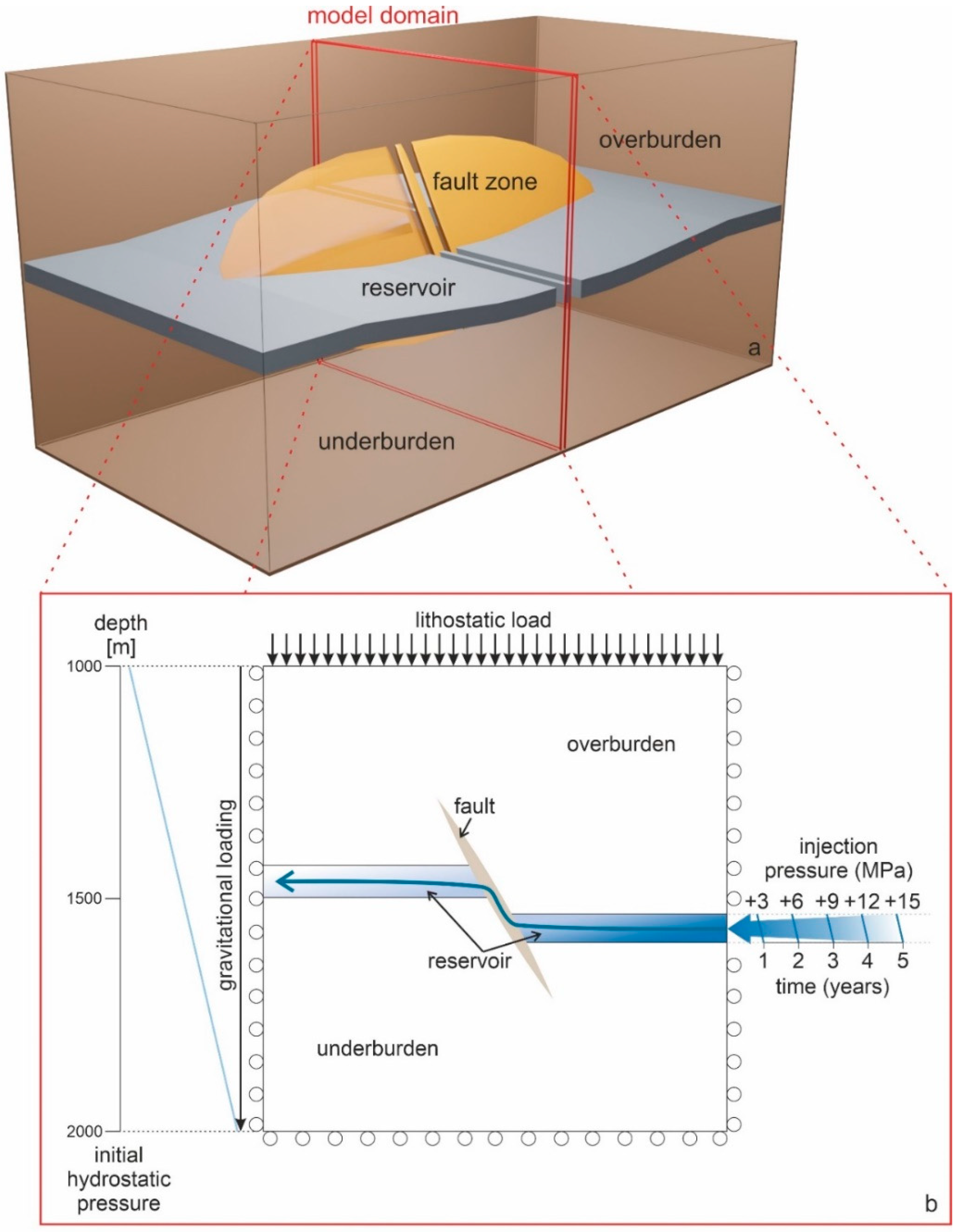


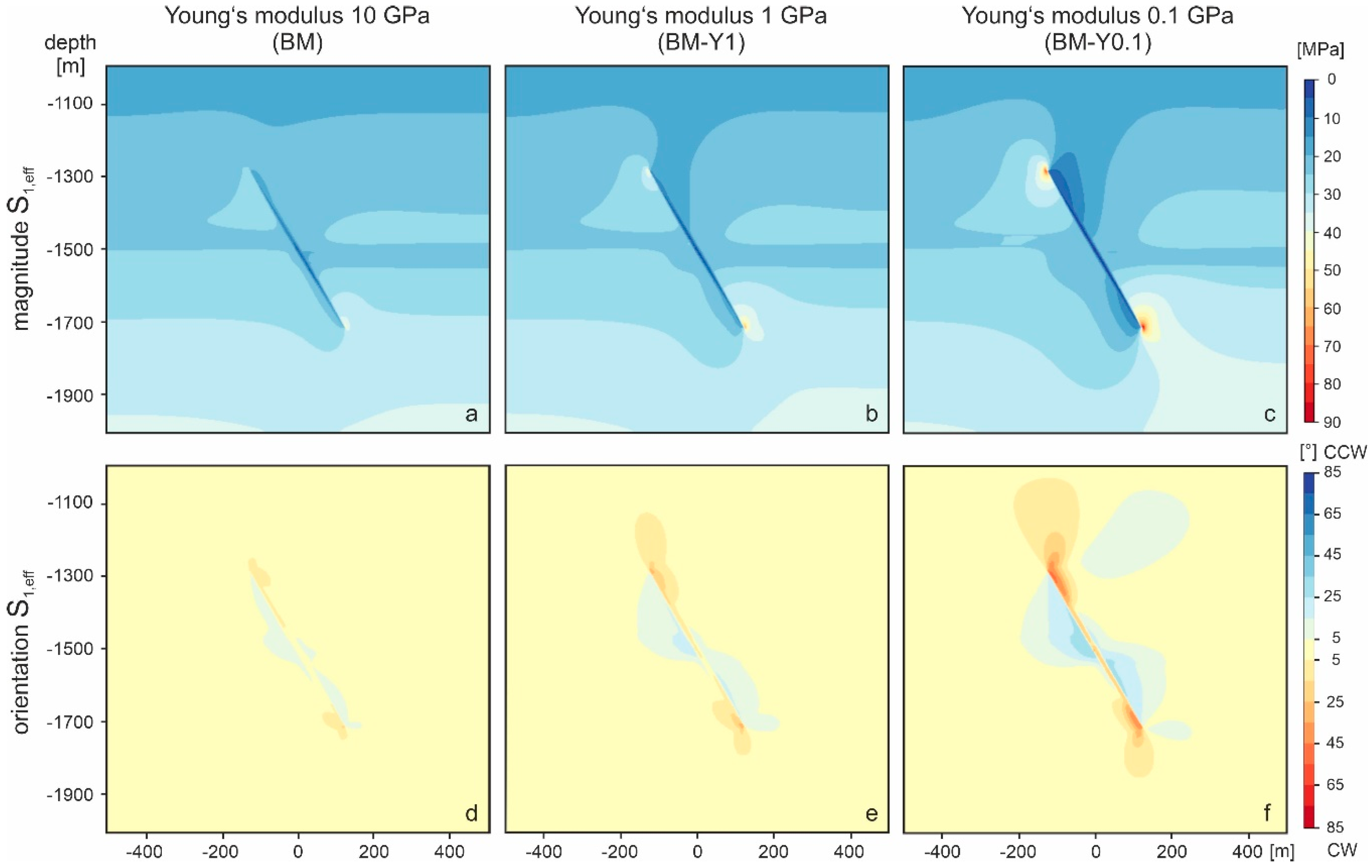
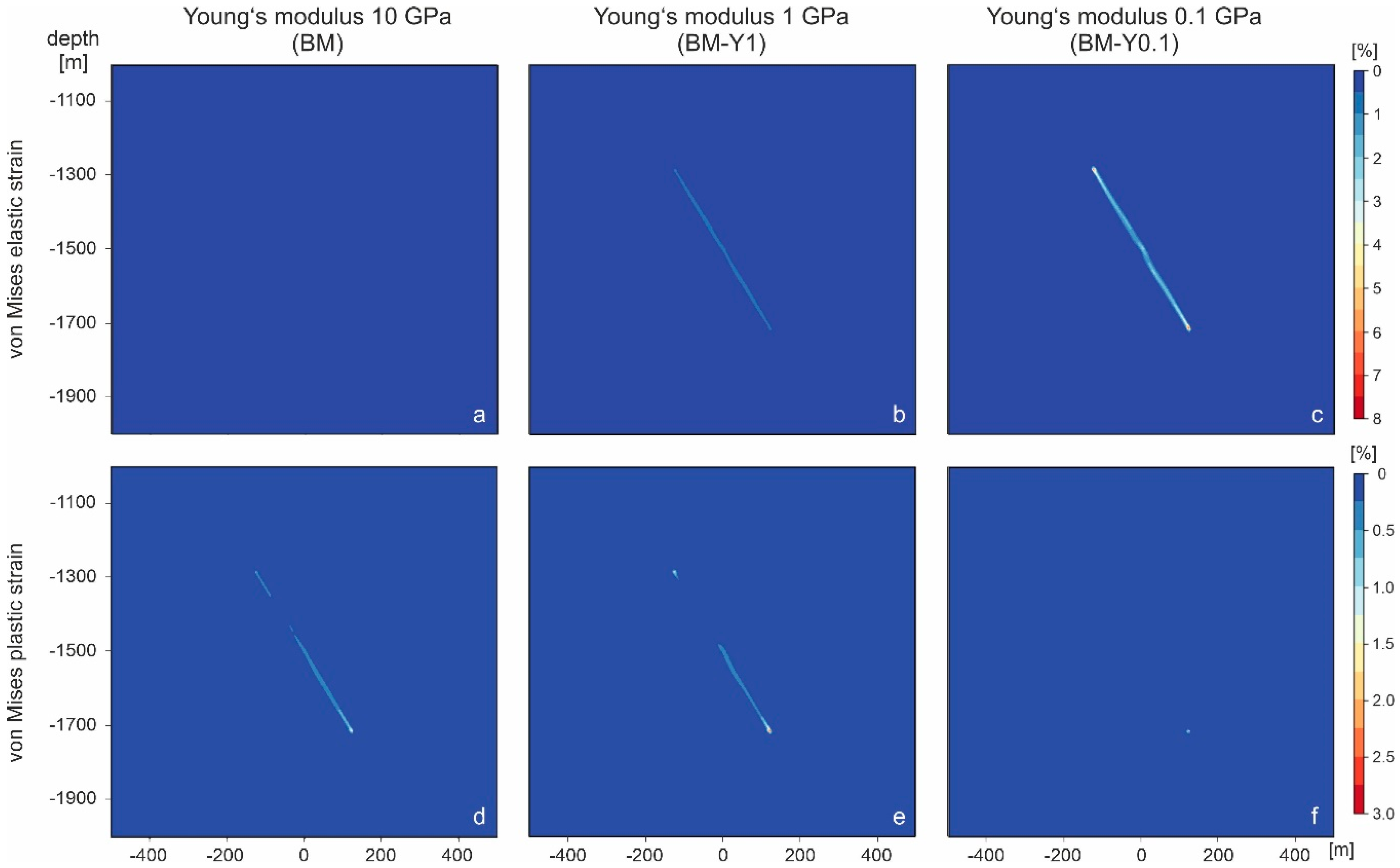
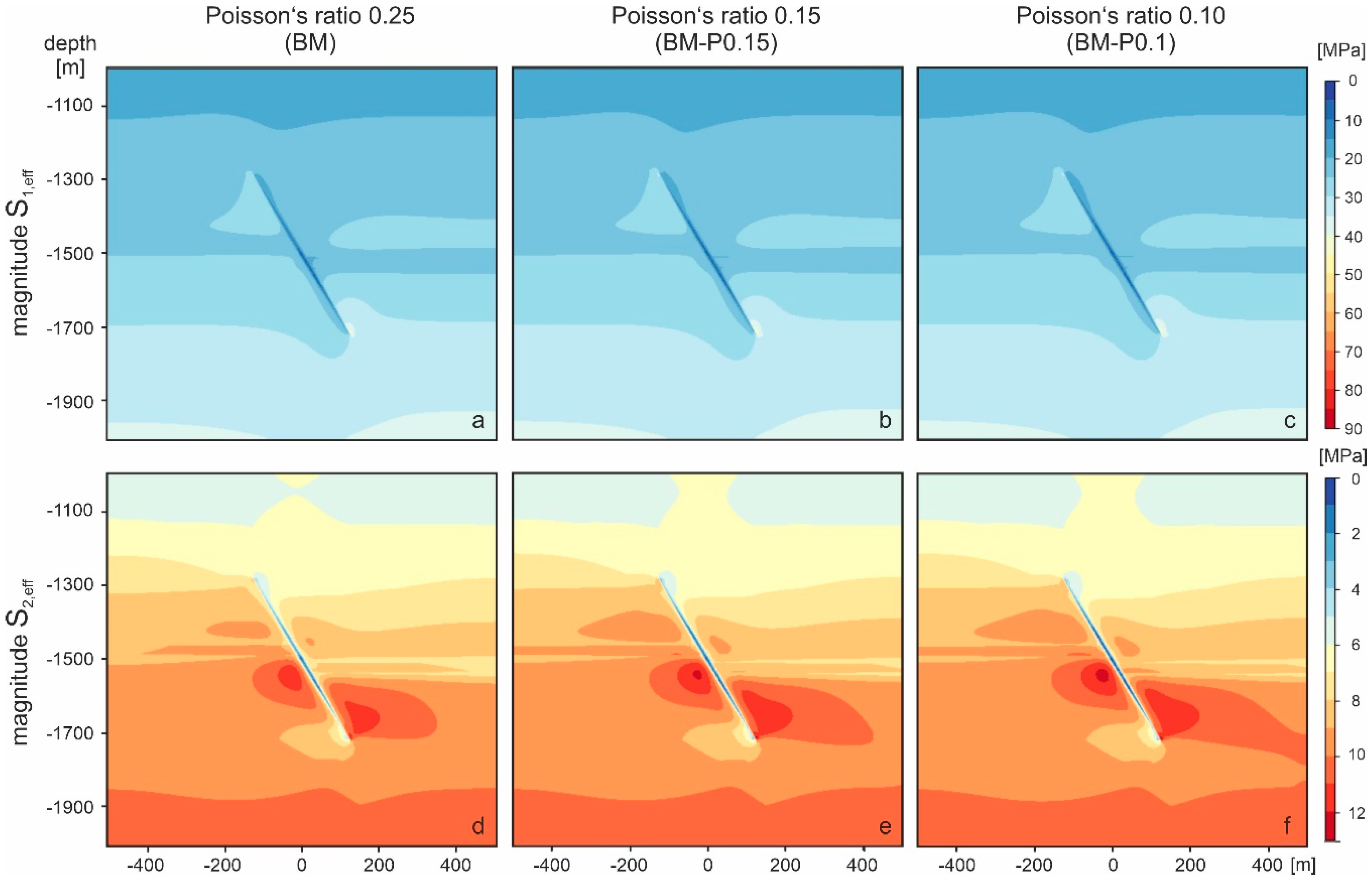
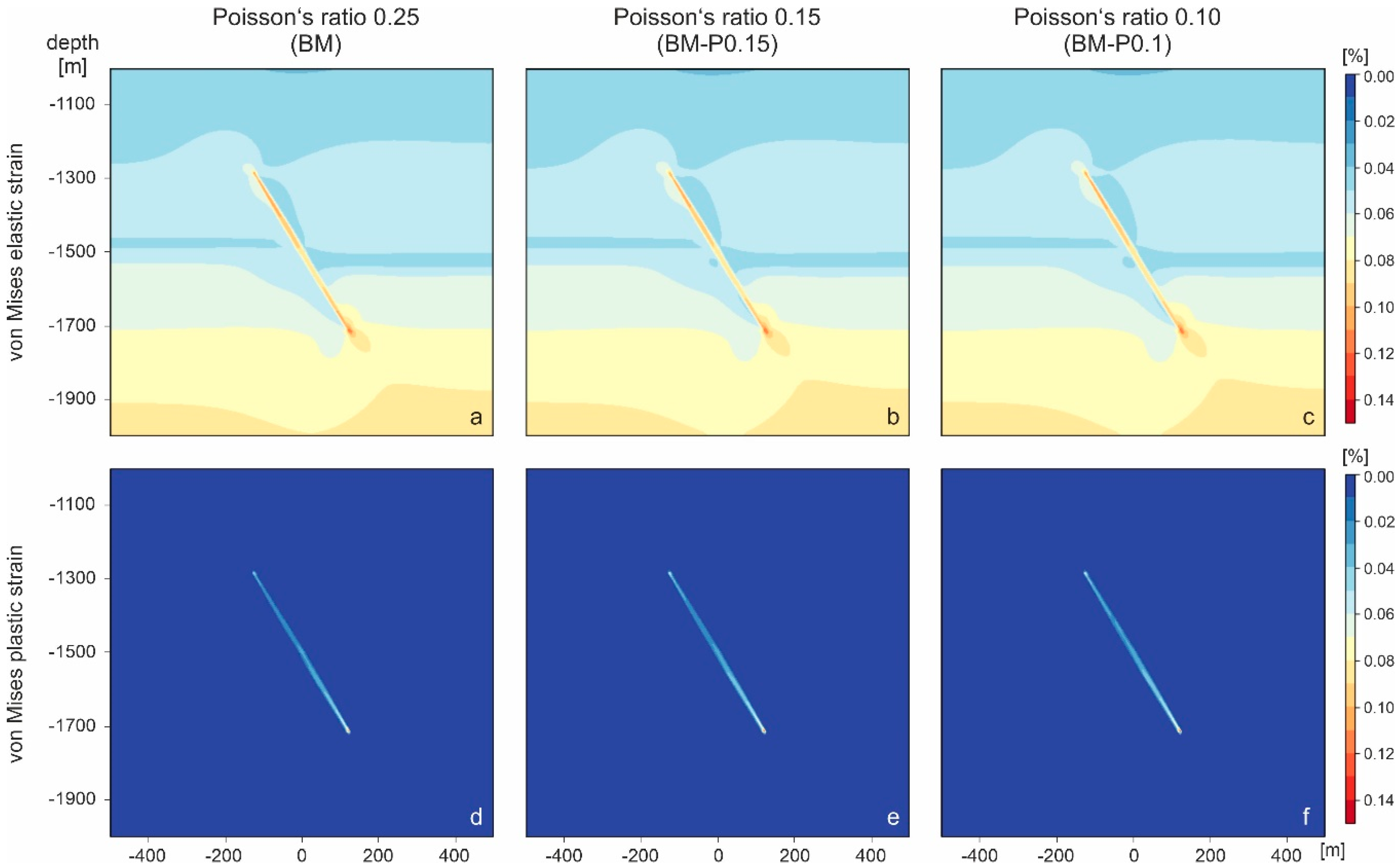
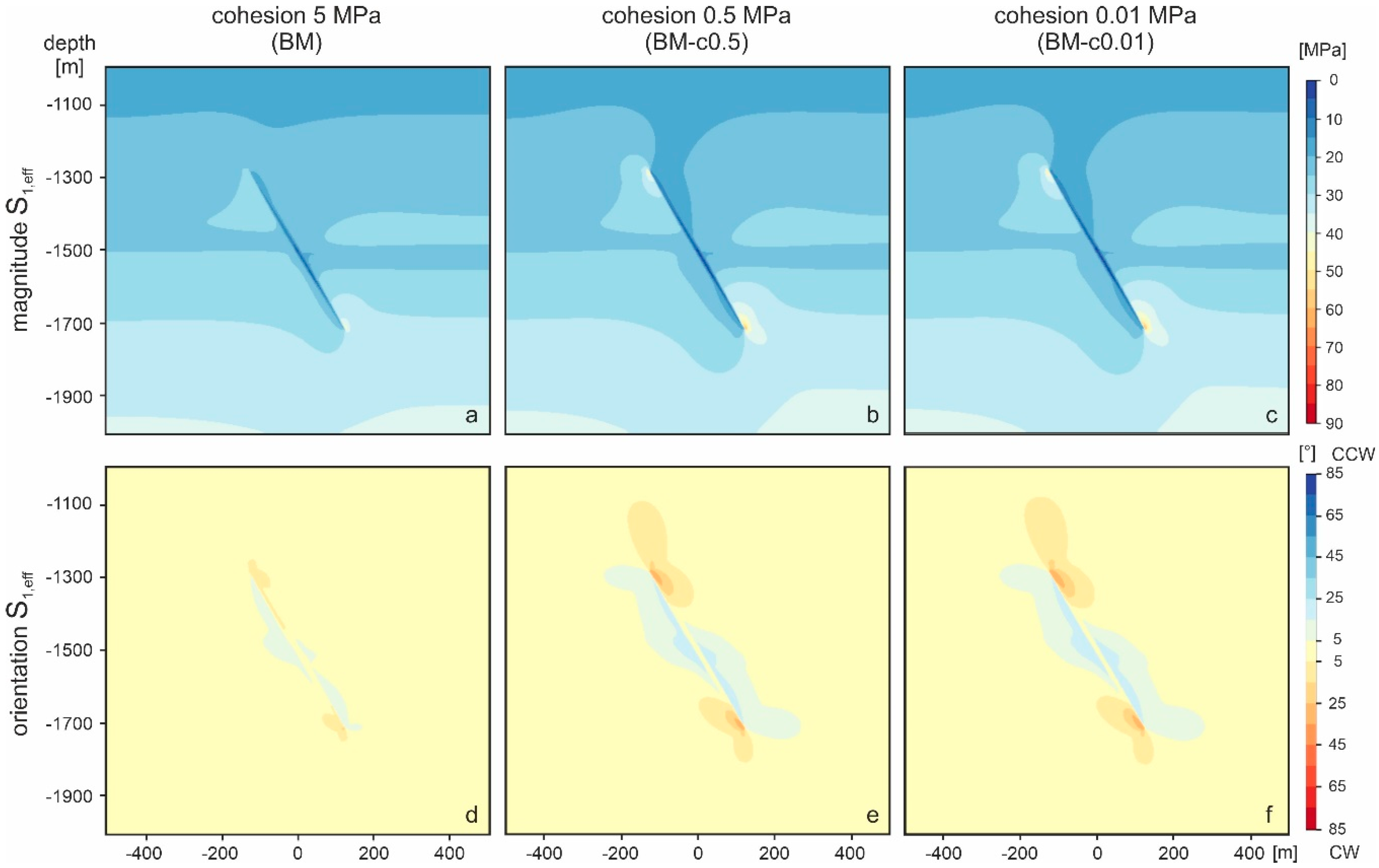

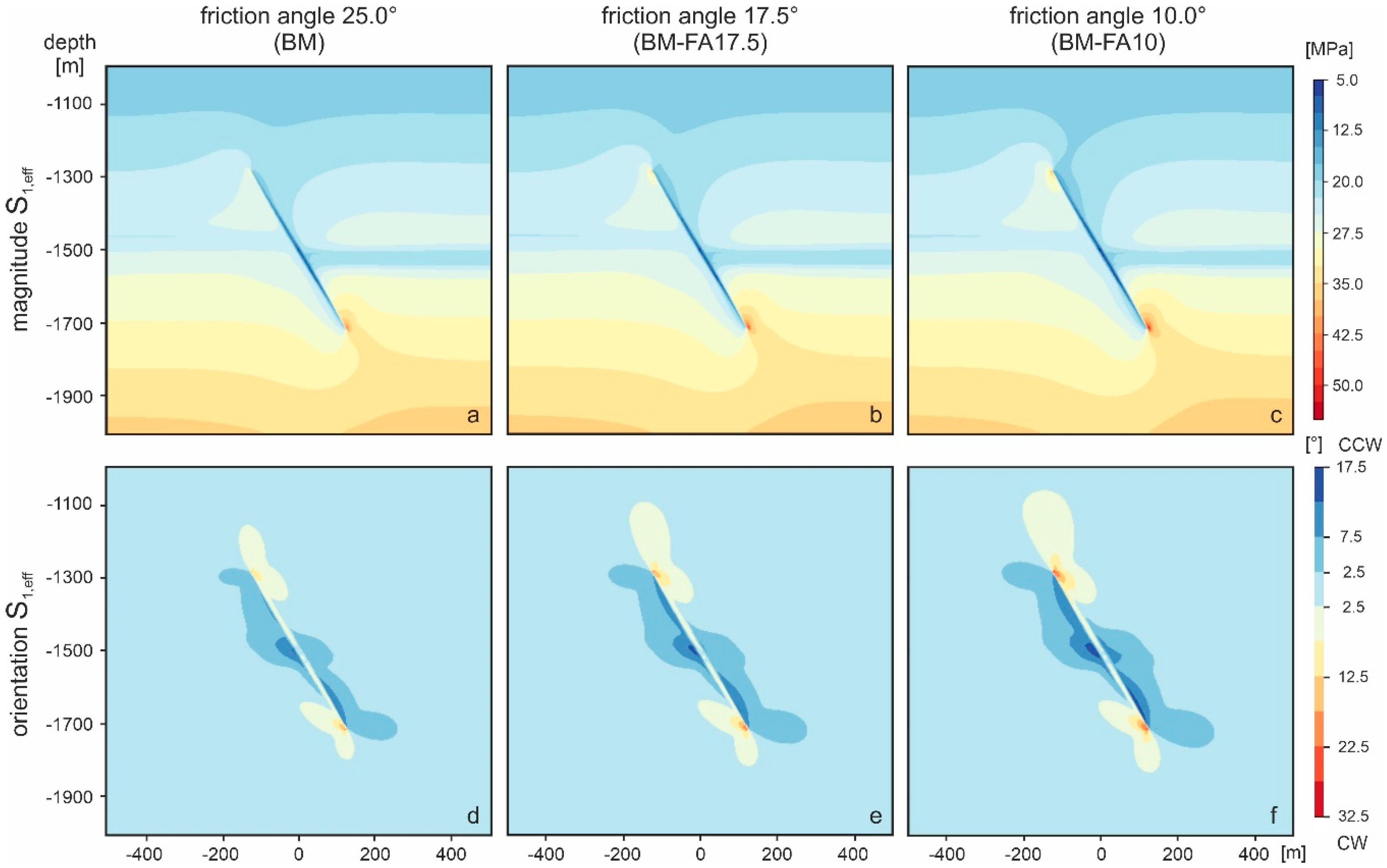
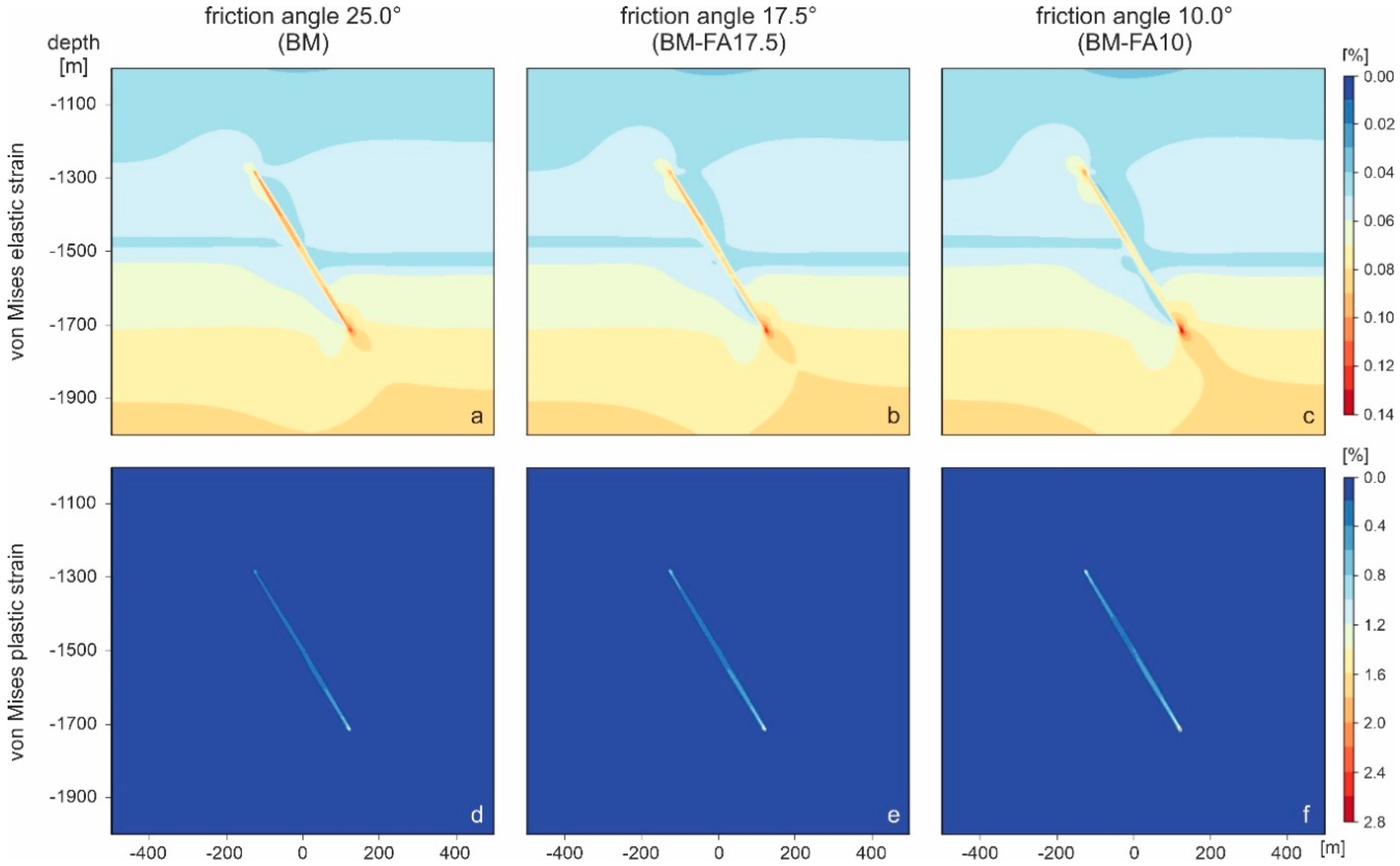

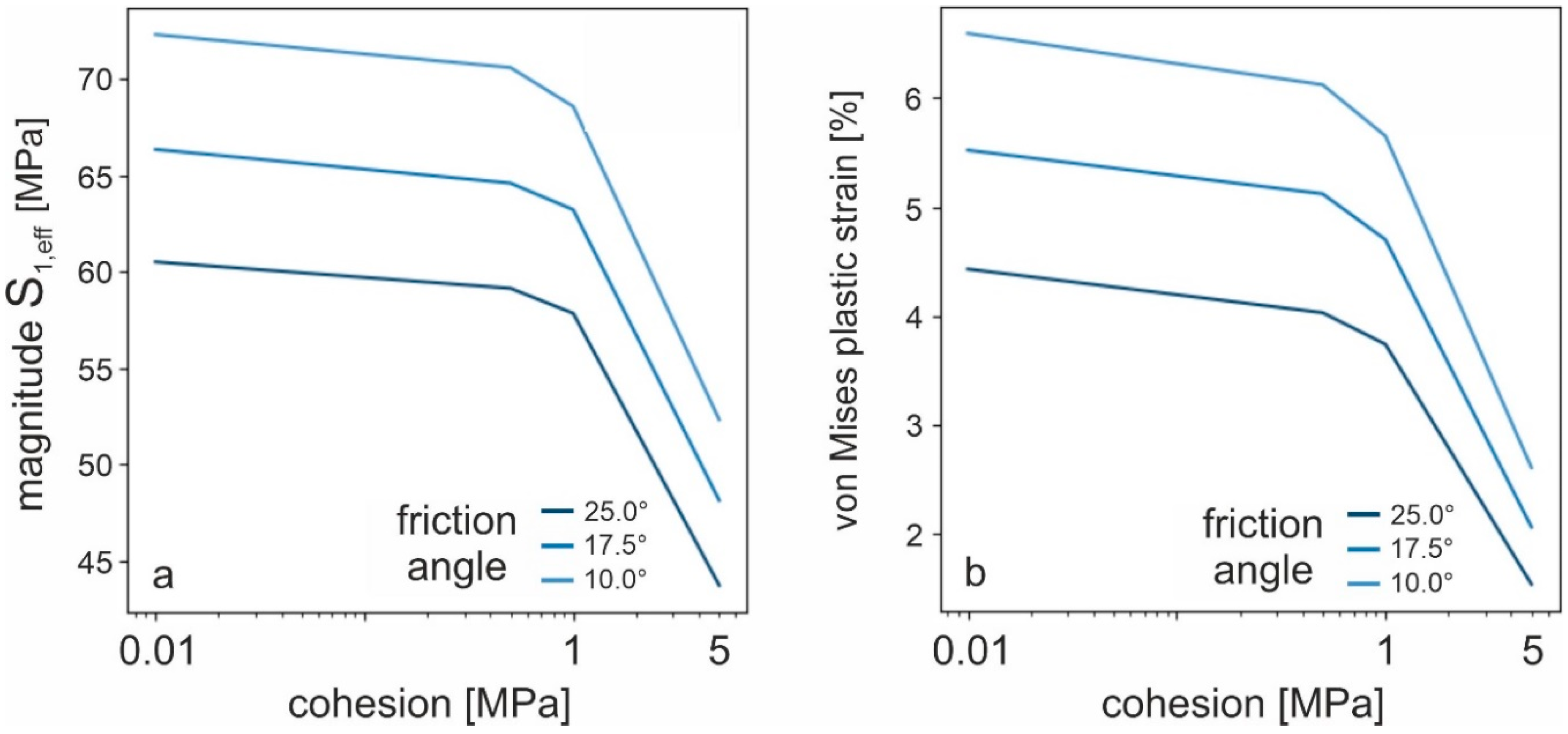
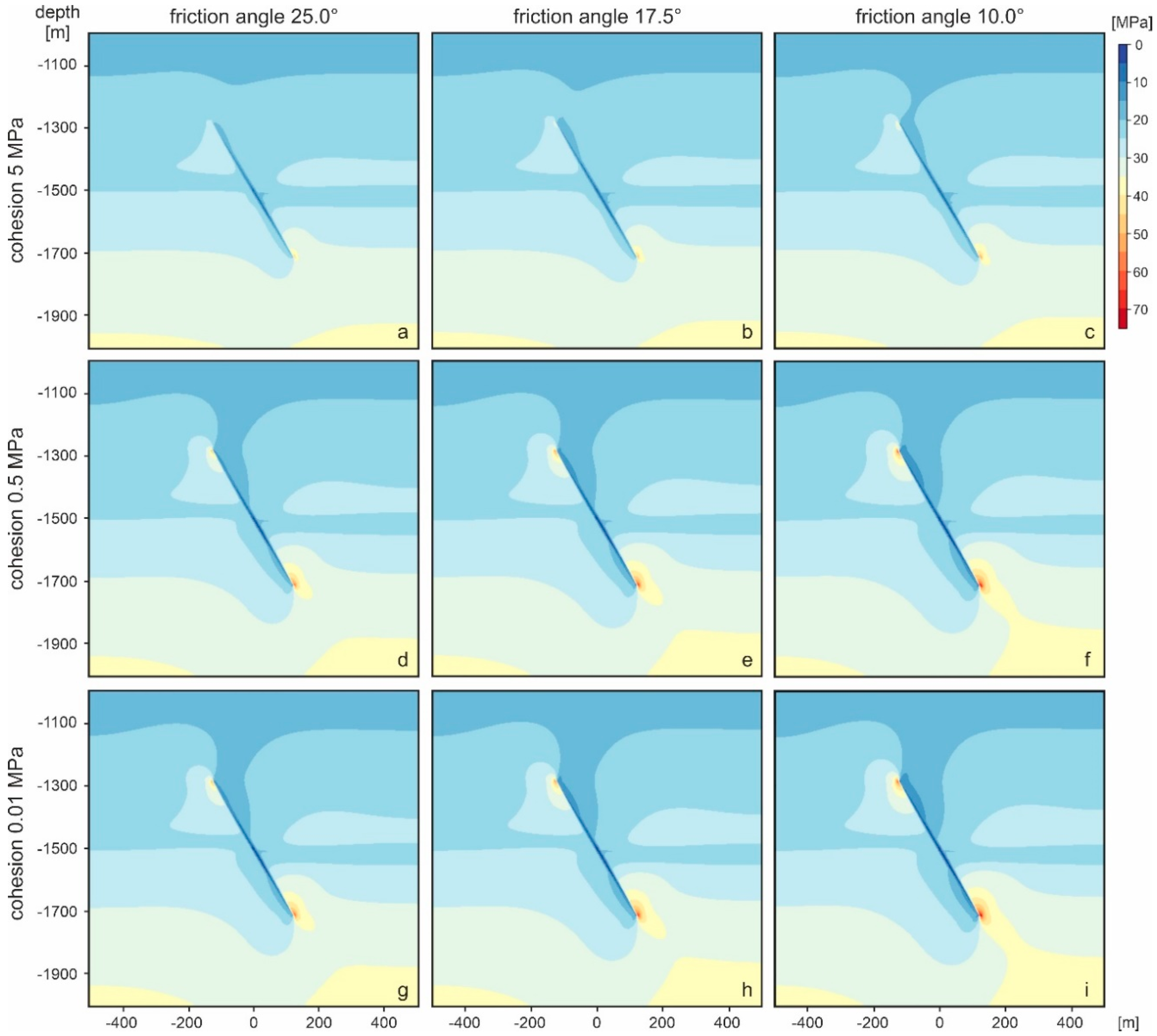
| Mechanical | Symbol | Fault Zone | Reservoir | Over-/Underburden |
|---|---|---|---|---|
| Young’s modulus (GPa) | E | 0.1–10 | 30 | 30 |
| Poissons’ ratio (-) | v | 0.1–0.25 | 0.23 | 0.23 |
| Friction angle (°) | φ | 10–25 | 40 | 40 |
| Cohesion (MPa) | c | 0.01–5 | 20 | 20 |
| Tensile strength (MPa) | T0 | 5 | 20 | 20 |
| Density (kg/m3) | ρ | 2400 | 2400 | 2400 |
| Hydraulic | ||||
| Biot coefficient (-) | α | 0.9 | 0.5 | 0.5 |
| Permeability (m2) | k | 10−14 | 5−12 | 10−17 |
| Model Name | Young’s Modulus (GPa) | Poisson’s Ratio (-) | Cohesion (MPa) | Friction Angle (°) |
|---|---|---|---|---|
| BM | 10 | 0.25 | 5 | 25.0 |
| BM-P0.20 | 10 | 0.20 | 5 | 25.0 |
| BM-P0.15 | 10 | 0.15 | 5 | 25.0 |
| BM-P0.10 | 10 | 0.10 | 5 | 25.0 |
| BM-FA17.5 | 10 | 0.25 | 5 | 17.5 |
| BM-FA10.0 | 10 | 0.25 | 5 | 10.0 |
| BM-c1 | 10 | 0.25 | 1 | 25.0 |
| BM-c1-FA17.5 | 10 | 0.25 | 1 | 17.5 |
| BM-c1-FA10.0 | 10 | 0.25 | 1 | 10.0 |
| BM-c0.5 | 10 | 0.25 | 0.5 | 25.0 |
| BM-c0.5-FA17.5 | 10 | 0.25 | 0.5 | 17.5 |
| BM-c0.5-FA10.0 | 10 | 0.25 | 0.5 | 10.0 |
| BM-c0.1 | 10 | 0.25 | 0.1 | 25.0 |
| BM-c0.1-FA17.5 | 10 | 0.25 | 0.1 | 17.5 |
| BM-c0.1-FA10.0 | 10 | 0.25 | 0.1 | 10.0 |
| BM-c0.05 | 10 | 0.25 | 0.05 | 25.0 |
| BM-c0.05-FA17.5 | 10 | 0.25 | 0.05 | 17.5 |
| BM-c0.05-FA10.0 | 10 | 0.25 | 0.05 | 10.0 |
| BM-c0.01 | 10 | 0.25 | 0.01 | 25.0 |
| BM-c0.01-FA17.5 | 10 | 0.25 | 0.01 | 17.5 |
| BM-c0.01-FA10.0 | 10 | 0.25 | 0.01 | 10.0 |
| BM-Y7 | 7 | 0.25 | 5 | 25.0 |
| BM-Y7-P0.20 | 7 | 0.25 | 5 | 25.0 |
| BM-Y7-P0.15 | 7 | 0.25 | 5 | 25.0 |
| BM-Y7-P0.10 | 7 | 0.25 | 5 | 25.0 |
| BM-Y5 | 5 | 0.25 | 5 | 25.0 |
| BM-Y5-P0.20 | 5 | 0.25 | 5 | 25.0 |
| BM-Y5-P0.15 | 5 | 0.25 | 5 | 25.0 |
| BM-Y5-P0.10 | 5 | 0.25 | 5 | 25.0 |
| BM-Y3 | 3 | 0.25 | 5 | 25.0 |
| BM-Y3-P0.20 | 3 | 0.25 | 5 | 25.0 |
| BM-Y3-P0.15 | 3 | 0.25 | 5 | 25.0 |
| BM-Y3-P0.10 | 3 | 0.25 | 5 | 25.0 |
| BM-Y1 | 1 | 0.25 | 5 | 25.0 |
| BM-Y1-P0.20 | 1 | 0.20 | 5 | 25.0 |
| BM-Y1-P0.15 | 1 | 0.15 | 5 | 25.0 |
| BM-Y1-P0.10 | 1 | 0.10 | 5 | 25.0 |
| BM-Y1-FA17.5 | 1 | 0.25 | 5 | 17.5 |
| BM-Y1-FA10.0 | 1 | 0.25 | 5 | 10.0 |
| BM-Y1-c1 | 1 | 0.25 | 1 | 25.0 |
| BM-Y1-c1-FA17.5 | 1 | 0.25 | 1 | 17.5 |
| BM-Y1-c1-FA10.0 | 1 | 0.25 | 1 | 10.0 |
| BM-Y1-c0.5 | 1 | 0.25 | 0.5 | 25.0 |
| BM-Y1-c0.5-FA17.5 | 1 | 0.25 | 0.5 | 17.5 |
| BM-Y1-c0.5-FA10.0 | 1 | 0.25 | 0.5 | 10.0 |
| BM-Y1-c0.1 | 1 | 0.25 | 0.1 | 25.0 |
| BM-Y1-c0.1-FA17.5 | 1 | 0.25 | 0.1 | 17.5 |
| BM-Y1-c0.1-FA10.0 | 1 | 0.25 | 0.1 | 10.0 |
| BM-Y1-c0.05 | 1 | 0.25 | 0.05 | 25.0 |
| BM-Y1-c0.05-FA17.5 | 1 | 0.25 | 0.05 | 17.5 |
| BM-Y1-c0.05-FA10.0 | 1 | 0.25 | 0.05 | 10.0 |
| BM-Y1-c0.01 | 1 | 0.25 | 0.01 | 25.0 |
| BM-Y1-c0.01-FA17.5 | 1 | 0.25 | 0.01 | 17.5 |
| BM-Y1-c0.01-FA10.0 | 1 | 0.25 | 0.01 | 10.0 |
| BM-Y0.7 | 0.7 | 0.25 | 5 | 25.0 |
| BM-Y0.7-P0.20 | 0.7 | 0.25 | 5 | 25.0 |
| BM-Y0.7-P0.15 | 0.7 | 0.25 | 5 | 25.0 |
| BM-Y0.7-P0.10 | 0.7 | 0.25 | 5 | 25.0 |
| BM-Y0.5 | 0.5 | 0.25 | 5 | 25.0 |
| BM-Y0.5-P0.20 | 0.5 | 0.25 | 5 | 25.0 |
| BM-Y0.5-P015 | 0.5 | 0.25 | 5 | 25.0 |
| BM-Y0.5-P0.10 | 0.5 | 0.25 | 5 | 25.0 |
| BM-Y0.3 | 0.3 | 0.25 | 5 | 25.0 |
| BM-Y0.3-P0.20 | 0.3 | 0.25 | 5 | 25.0 |
| BM-Y0.3-P0.15 | 0.3 | 0.25 | 5 | 25.0 |
| BM-Y0.3-P0.10 | 0.3 | 0.25 | 5 | 25.0 |
| BM-Y0.1 | 0.1 | 0.25 | 5 | 25.0 |
| BM-Y0.1-P0.20 | 0.1 | 0.20 | 5 | 25.0 |
| BM-Y0.1-P0.15 | 0.1 | 0.15 | 5 | 25.0 |
| BM-Y0.1-P0.10 | 0.1 | 0.10 | 5 | 25.0 |
| BM-Y0.1-FA17.5 | 0.1 | 0.25 | 5 | 17.5 |
| BM-Y0.1-FA10.0 | 0.1 | 0.25 | 5 | 10.0 |
| BM-Y0.1-c1 | 0.1 | 0.25 | 1 | 25.0 |
| BM-Y0.1-c1-FA17.5 | 0.1 | 0.25 | 1 | 17.5 |
| BM-Y0.1-c1-FA10.0 | 0.1 | 0.25 | 1 | 10.0 |
| BM-Y0.1-c0.5 | 0.1 | 0.25 | 0.5 | 25.0 |
| BM-Y0.1-c0.5-FA17.5 | 0.1 | 0.25 | 0.5 | 17.5 |
| BM-Y0.1-c0.5-FA10.0 | 0.1 | 0.25 | 0.5 | 10.0 |
| BM-Y0.1-c0.1 | 0.1 | 0.25 | 0.1 | 25.0 |
| BM-Y0.1-c0.1-FA17.5 | 0.1 | 0.25 | 0.1 | 17.5 |
| BM-Y0.1-c0.1-FA10.0 | 0.1 | 0.25 | 0.1 | 10.0 |
| BM-Y0.1-c0.05 | 0.1 | 0.25 | 0.05 | 25.0 |
| BM-Y0.1-c0.05-FA17.5 | 0.1 | 0.25 | 0.05 | 17.5 |
| BM-Y0.1-c0.05-FA10.0 | 0.1 | 0.25 | 0.05 | 10.0 |
| BM-Y0.1-c0.01 | 0.1 | 0.25 | 0.01 | 25.0 |
| BM-Y0.1-c0.01-FA17.5 | 0.1 | 0.25 | 0.01 | 17.5 |
| BM-Y0.1-c0.01-FA10.0 | 0.1 | 0.25 | 0.01 | 10.0 |
© 2020 by the authors. Licensee MDPI, Basel, Switzerland. This article is an open access article distributed under the terms and conditions of the Creative Commons Attribution (CC BY) license (http://creativecommons.org/licenses/by/4.0/).
Share and Cite
Treffeisen, T.; Henk, A. Elastic and Frictional Properties of Fault Zones in Reservoir-Scale Hydro-Mechanical Models—A Sensitivity Study. Energies 2020, 13, 4606. https://doi.org/10.3390/en13184606
Treffeisen T, Henk A. Elastic and Frictional Properties of Fault Zones in Reservoir-Scale Hydro-Mechanical Models—A Sensitivity Study. Energies. 2020; 13(18):4606. https://doi.org/10.3390/en13184606
Chicago/Turabian StyleTreffeisen, Torben, and Andreas Henk. 2020. "Elastic and Frictional Properties of Fault Zones in Reservoir-Scale Hydro-Mechanical Models—A Sensitivity Study" Energies 13, no. 18: 4606. https://doi.org/10.3390/en13184606





